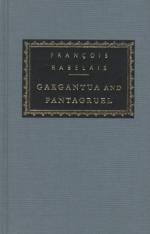appeal was drawn to the life; and in the other a servant
that wants a master, with every needful particular,
action, countenance, look, gait, feature, and deportment,
being an original by Master Charles Charmois, principal
painter to King Megistus; and he paid for them in the
court fashion, with conge and grimace. Panurge
bought a large picture, copied and done from the needle-work
formerly wrought by Philomela, showing to her sister
Progne how her brother-in-law Tereus had by force handselled
her copyhold, and then cut out her tongue that she
might not (as women will) tell tales. I vow
and swear by the handle of my paper lantern that it
was a gallant, a mirific, nay, a most admirable piece.
Nor do you think, I pray you, that in it was the
picture of a man playing the beast with two backs
with a female; this had been too silly and gross:
no, no; it was another-guise thing, and much plainer.
You may, if you please, see it at Theleme, on the
left hand as you go into the high gallery. Epistemon
bought another, wherein were painted to the life the
ideas of Plato and the atoms of Epicurus. Rhizotome
purchased another, wherein Echo was drawn to the life.
Pantagruel caused to be bought, by Gymnast, the life
and deeds of Achilles, in seventy-eight pieces of
tapestry, four fathom long, and three fathom broad,
all of Phrygian silk, embossed with gold and silver;
the work beginning at the nuptials of Peleus and Thetis,
continuing to the birth of Achilles; his youth, described
by Statius Papinius; his warlike achievements, celebrated
by Homer; his death and obsequies, written by Ovid
and Quintus Calaber; and ending at the appearance of
his ghost, and Polyxena’s sacrifice, rehearsed
by Euripides.
He also caused to be bought three fine young unicorns;
one of them a male of a chestnut colour, and two grey
dappled females; also a tarand, whom he bought of
a Scythian of the Gelones’ country.
A tarand is an animal as big as a bullock, having
a head like a stag, or a little bigger, two stately
horns with large branches, cloven feet, hair long
like that of a furred Muscovite, I mean a bear, and
a skin almost as hard as steel armour. The Scythian
said that there are but few tarands to be found in
Scythia, because it varieth its colour according to
the diversity of the places where it grazes and abides,
and represents the colour of the grass, plants, trees,
shrubs, flowers, meadows, rocks, and generally of
all things near which it comes. It hath this
common with the sea-pulp, or polypus, with the thoes,
with the wolves of India, and with the chameleon,
which is a kind of a lizard so wonderful that Democritus
hath written a whole book of its figure and anatomy,
as also of its virtue and propriety in magic.
This I can affirm, that I have seen it change its
colour, not only at the approach of things that have
a colour, but by its own voluntary impulse, according
to its fear or other affections; as, for example,
upon a green carpet I have certainly seen it become




